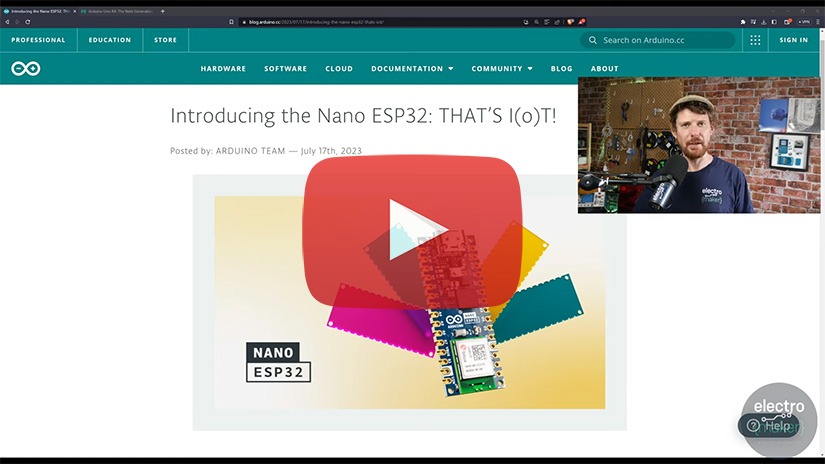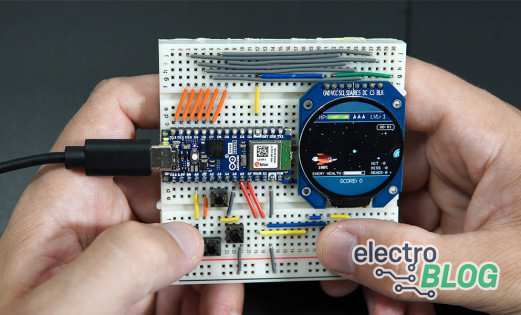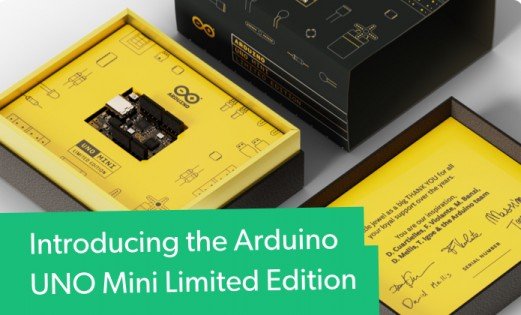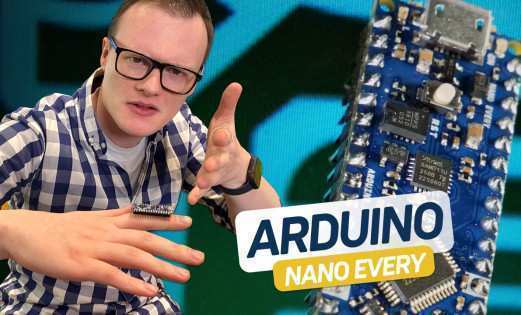Arduino Drops the Nano ESP32: A Mini IoT and MicroPython Powerhouse!
The Nano ESP32 has arrived, and it's ready to take the Arduino ecosystem by storm! Featuring the powerful ESP32-S3 microcontroller, this tiny yet mighty board brings the world of Arduino and MicroPython programming together like never before. Whether you're a newbie eager to dive into the exciting world of IoT and MicroPython or a seasoned pro seeking the perfect tool for your next project, the Nano ESP32 seems like the best of all worlds.
There's just one mystery - what's with the slightly cut-away USB Type-C port? It seems a small thing to bring up, but I've never seen one quite like it before, and other images of the new board make it look like you could bash the all-important inner connector wif you are a little hamfisted - however, that might well just be a me problem!
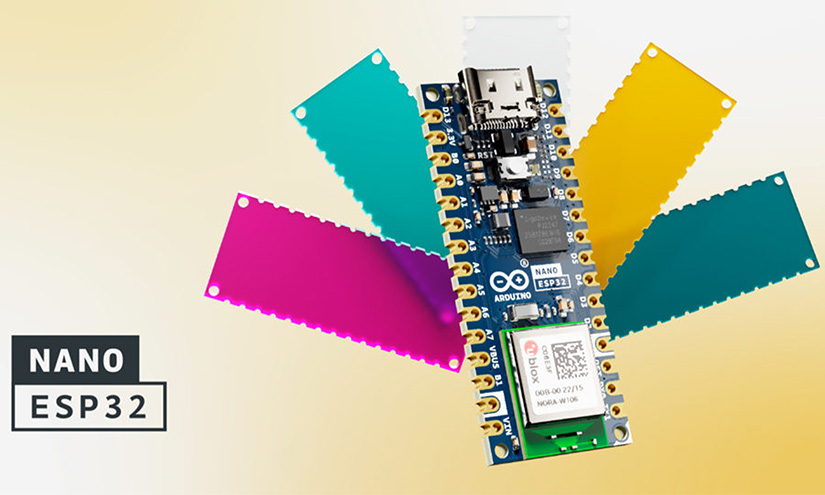
After all, the ESP32 has been the Maker's darling for a long time, and has always enjoyed community-driven Arduino IDE and MicroPython support. The super powerful ESP32-S3, with its dual-core high-speed processor and lower power RISC-V core for super low-power-draw operations, seems like the perfect SoC for the job.
The Arduino Nano ESP32: What Makes it Awesome?
We chatted about the Arduino Nano ESP32 in a section on this week's Electromaker Show:
Here's a quick rundown of the hits:
Compact Design: With the Nano ESP32, size is not an issue. Designed to fit seamlessly into your standalone projects, this board adheres to the well-known Nano form factor, making it an ideal choice for embedding into various applications.
Wi-Fi and Bluetooth Connectivity: The ESP32-S3 microcontroller's prowess in the IoT realm is renowned, and the Nano ESP32 fully leverages its capabilities. Enjoy full Arduino support for Wi-Fi and Bluetooth connectivity, empowering you to create wireless wonders with ease.
Dual Support for Arduino and MicroPython: Switching between Arduino and MicroPython programming has never been smoother. Seamlessly transition between the two with just a few simple steps. Plus, for those new to the MicroPython world, the Nano ESP32 offers an introductory course to get you started.
Arduino IoT Cloud Compatibility: Simplify your IoT projects by harnessing the power of the Arduino IoT Cloud. A few lines of code are all you need to create and manage your connected devices securely. Monitor and control your projects from anywhere using the Arduino IoT Cloud app (available starting August 2023) without worrying about security.
HID Support: Unlock a world of possibilities by emulating human interface devices like keyboards or mice over USB. Interact with your computer in innovative ways and take your projects to the next level.
It's quite the list of definitely-wants and nice-to-haves, and while we'll cover the full specs later in this article, the main draw here is familiarity. those who have worked with any Arduino Nano before will be right at home straight away with this board. Conversely, those who are starting out on their journey will find this board to be a pretty useful companion - from the very first blinking LED through to AIoT edge inference with cloud integration. Speaking of which...
Arduino IoT Cloud Compatible
It's no surprise that Arduino is leaning heavily on the IoT angle for this board, as super-fast AIoT ready dual core speedy/low power RISC-V steady hardware combo is perfectly set up for it. Wi-Fi enabled development boards have always been targets for DIY web-based projects. Unfortunately, getting a reliable cloud service that doesn't cost the earth has never been all that easy.
What's that, you say? Easy cloud integration that doesn't cost the earth? The Nano ESP32 effortlessly integrates with Arduino's IoT Cloud, offering a simple and secure communication solution for all your connected devices. The Arduino Cloud can be tried for free, and the Arduino Cloud smartphone app is also just around the corner, with a release date sometime in August. Interestingly, the Arduino docs already have a guide for the IoT Cloud app including instructions on getting a web integrated project up and running, along with adding different sensors and visualization tools.
The Arduino Nano ESP32 Full Specs
There aren't many surprises here, given how well-known both the ESP32-S3 SoC and the Nano form factor are, but it still stacks up to quite an impressive little powerhouse!
| Board | Name | Arduino® Nano ESP32 |
| SKU | ABX00092 | |
| Microcontroller | u-blox® NORA-W106 (ESP32-S3) | |
| USB connector | USB-C® | |
| Pins | Built-in LED Pin | 13 |
| Built-in RGB LED pins | 14-16 | |
| Digital I/O Pins | 14 | |
| Analog input pins | 8 | |
| PWM pins | 5 | |
| External interrupts | All digital pins | |
| Connectivity | Wi-Fi® | u-blox® NORA-W106 (ESP32-S3) |
| Bluetooth® | u-blox® NORA-W106 (ESP32-S3) | |
| Communication | UART | 2x |
| I2C | 1x, A4 (SDA), A5 (SCL) | |
| SPI | D11 (COPI), D12 (CIPO), D13 (SCK). Use any GPIO for Chip Select (CS) | |
| Power | I/O Voltage | 3.3 V |
| Input voltage (nominal) | 6-21 V | |
| Source Current per I/O Pin | 40 mA | |
| Sink Current per I/O Pin | 28 mA | |
| Clock speed | Processor | up to 240 MHz |
| Memory | ROM | 384 kB |
| SRAM | 512 kB | |
| External Flash | 128 Mbit (16 MB) | |
| Dimensions | Width | 18 mm |
| Length | 45 mm | |
Arduino Joins the ESP32 Party
It seemed like only a matter of time until Arduino put out an ESP32-focused board, and the Nano is the perfect form for it. Many of the boards in the Nano line were already running at 3.3v, and given the lack of shields and accessories designed purely for the Nano it seems a safe bet to finally sever the tie between the old ATMega328p-based 5v tolerant boards and the dizzying array of Nano variants available today.
Interestingly, this is the same philosophy behind the new Arduino Uno R4 Wi-Fi, which also recently appeared sporting an ESP32 coprocessor for connectivity. There was no shortage of snide comments asking why Arduino had relegated the ESP to a coprocessor without really stopping to look at the Renesas RA4M1 (Arm Cortex-M4) chip it uses as a main processor.
As well as powering the Minima (the non-Wi-Fi version without the LED matrix), the Renesas SoC is 5v tolerant, making both the Minima and Wi-Fi Uno R4 completely backward compatible with all Arduino Shields and accessories.
Between the Uno R4 and the Nano ESP32, Arduino has managed something quite incredible - to carry on the legacy of Arduino compatibility and simplicity while staying 100% relevant to modern hardware standards. No mean feat!
The Arduino store has both the Uno R4 and the Nano ESP32 available now!




